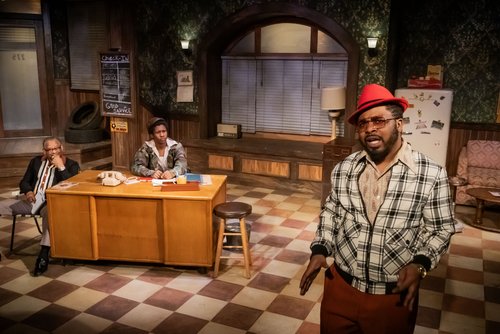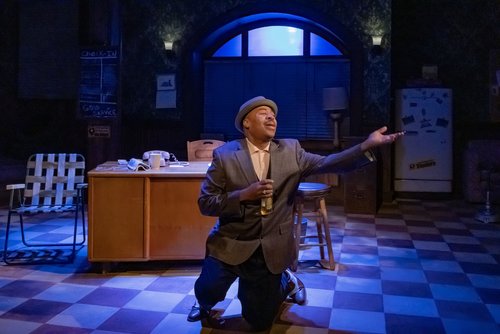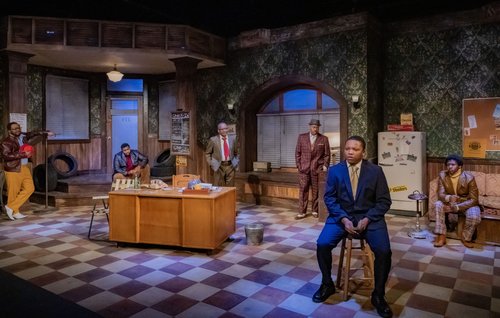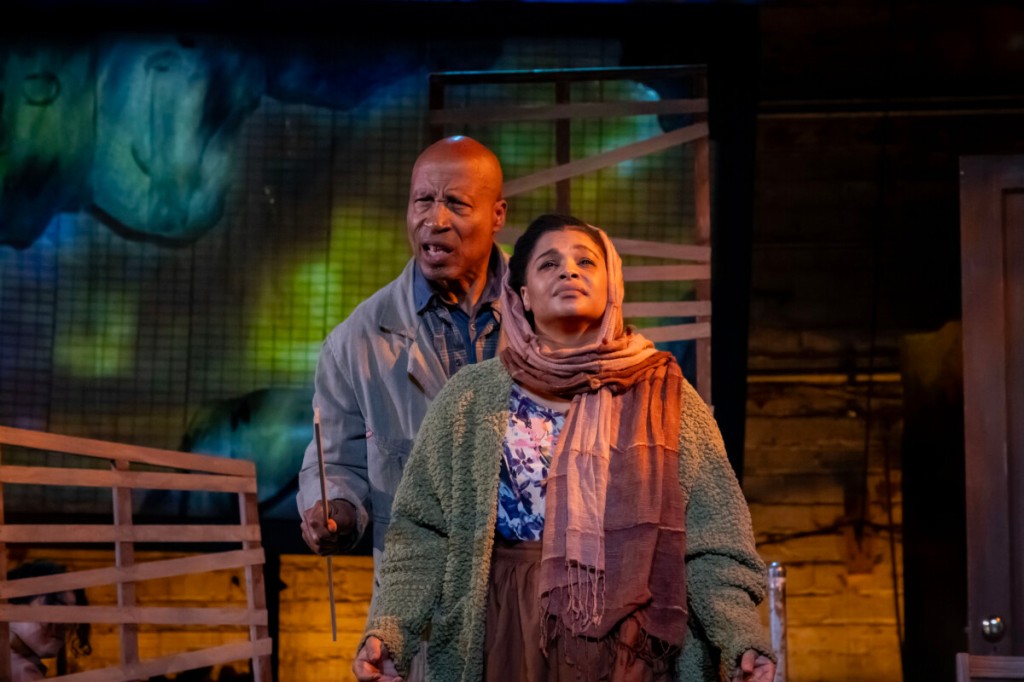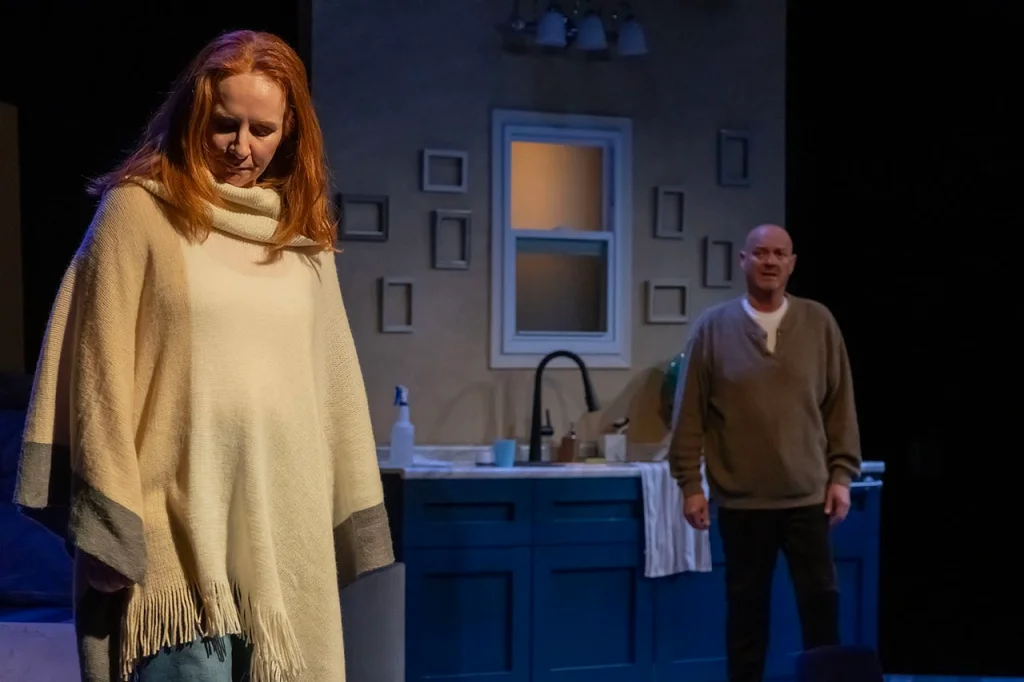Written by Rachel Bublitz and directed by Paige Conway, Cleveland Public Theatre’s Funny, Like an Abortion depicts the state of restrictions and criminalization of abortion in the future—a variation of George Orwell’s 1984. The blurb states that the play is about “loyalty, friendship, and the value of freedom.” The questions might be, “loyalty to whom/what,” “what kind of friendship,” and “whose freedom”? Indeed, the government of this script asks people to be loyal to their draconian laws, asking people to turn in their friends “and sacrifice their freedom to feel safe and happy and to build true relationships with others.
Director Conway uses active, physical acting to entertain the audience, especially when conversations and arguments get heavy. Andrea de la Fuente, as Monroe, who hosts this abortion party for herself, speaks as she juggles three pill bottles. Maggie Adler, as Jade—Munroe’s only friend she can trust—dances and trampolines. Both characters choreograph to anticipate each other’s movement to touch each other. Once, de la Fuente carries Adler (who is taller) on her shoulder. Toward the end, the audience becomes aware that they are perhaps one person with two conflicting decisions.
Both de La Fuente and Adler successfully tackled their difficult roles as real/meta-real characters. Sometimes, catching their lines was difficult because their actions were very demanding. Their movement reflects Conway’s directorial approach; as she states in her program note, when we lack the words, “we move.”
Scenic designer Laura Carlson Tarantowski created Monroe’s tiny room realistically with futuristic and dystopian elements such as hidden “cameras” and speakers. A couch, one exterior door, and two openings (one to the bathroom area and the other to the kitchen with a refrigerator), a side table, and a mini trampoline, and bookshelves with a lot of “stuff.” Props designer Lisa L. Wiley prepared many paper gift bags, which are aligned downstage, adding another level of chaotic festivity to the scenery. The proscenium arch has a unique “art deco” with hangers—eerily suggesting what is to come.
Lighting designer Libby Zamiska controls the intensity and tones of lighting to impart a sense of supernatural and magic realism. Sound designer Angie Hayes prepares the music selections for Conway to make this show a piece with different dimensions of the universe.
Costume designer Amanda Rowe-Van Allen chose a distinctive color scheme of golden, red, and green. The legs of Monroe’s pants are two different shades of red. Monroe’s t-shirt has an appliqued and sequined pop cat’s face in juxtaposition with her serious situation.
Sound Designer Angie Hayes mixed sounds and different music pieces to create the aura of a fairground, playground, birthday party, or circus.
The teach-in section toward the end of the show synthesizes a chaotic series of actions that introduce different methods of abortion—including old wives’ tales—nicely to make the show’s “point” clear and direct—anti-abortion policies and laws that deprive women of choices would result in many dangerous, harmful and tragic results.
Funny, Like an Abortion is a didactic comedy with so many heavy issues about humans losing their freedom, happiness, and fundamental rights as the nation becomes more dictatorial, oppressive, discriminatory, and punitive—as seen in Margaret Atwood’s The Handmaid’s Tale. A stuffed animal—a moose—symbolizes a flight to Canada, resonating with “Canada” portrayed as a safe haven for refugees from Gilead in The Handmaid’s Tale in season 5.
Almost two years have passed since the Supreme Court eliminated the federal constitutional right to abortion. More and more states tried to introduce and legislate a six-week abortion ban. In February 2024, Alabama’s Supreme Court ruled that frozen embryos are children. What the play does not mention—but is important to remember as an absurd argument of those who try to “protect” fetuses at any stage is that they would never consider providing healthcare, decent housing, health insurance, and decent means to rear children.
Funny, Like An Abortion was originally developed for PlayGrounds’ 25th and 26th Festival of New Works, with Jim Kleinmann as Artistic Director. With its clear message and physical theatricality, this play is truly impactful. The Ohio Statehouse needs to view this show in order to fully exercise its mission with dignity and humanity.
Director & Line Producer: Paige Conway
Stage Manager: Yesenia Real
Scenic Designer: Laura Carlson Tarantowski
Lighting Designer: Libby Zamiska
Costume Designer: Amanda Rowe-Van Allen
Sound Designer: Angie Hayes
Props Designer: Lisa L. Wiley
Executive Producer: Raymond Bobgan
Photographer: Steven Wagner
World Premiere.
April 25, 2024 – May 11, 2024



























